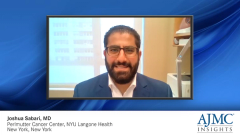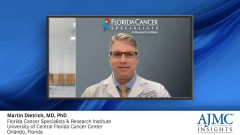
The Future of NSCLC Management
Our experts conclude with their final thoughts on the future of NSCLC treatment.
Episodes in this series

Alexander Spira, MD, PhD, FACP: The future of non-small cell lung cancer has changed because it's going to not be 1 disease. We're not calling it lung cancer anymore. We used to just call it non-small cell lung cancer. Then it was squamous and adenocarcinoma, but it's going to be defined by what their mutation is and what the best way it is to treat them in the frontline, second-, and third-line settings. Most of our patients still don't have a targetable mutation, so we are getting new non targetable drugs. ADCs [antibody-drug conjugates] are a way forward and new immunotherapies as well, but it's going to be a hodgepodge of different diseases. How do we manage them all differently with the appropriate drugs, and then what are the second- or the third-line drugs? Finally, most importantly, here is a plug for clinical trials. All of this wouldn't be possible without the physicians, pharma, and our patients' work, and we have to do a better job of getting more patients on clinical trials and evaluating new drugs. COVID-19 [coronavirus] and the crazy world of last 2 years has complicated manners and made it more challenging, but that has to be the most important focus of what we do. If you're a lung cancer physician, it's hard to keep up. From the patient perspective, make sure you work with your doctor, ask questions, and realize that lung cancer is not what it used to be 25 years ago, or even 5 years ago. We have more treatments. Lastly, for physicians or other providers that are watching this or involved in patient care, make sure you're doing your patients a service by checking for all these mutations, number one, but also [enter them into] clinical trials. Find patients for your clinical studies, and refer them. They're out there, and it's a great time for our patients.
Joshua Sabari, MD: In the future, combinations are going to be critical in the management of advanced non-small cell lung cancer. We have already seen that in the driver negative population, right? Chemotherapy, which was standard of care in the frontline setting up until 2016, has now been replaced by pembrolizumab as a single agent in the PDL-1 high [population]. Clearly, we need to do more. We need to improve on the durability of this response, and hopefully [find a] cure. Right now, a PDL-1 high patient, 50% or greater PDL-1, has a 33% chance of being alive and well at 5 years. That's amazing compared to where we were 5 or 6 years ago when the 5-year survival was in the 5%–10% range. Combination strategies in the frontline PDL-1 high patient population are ongoing. In the PDL-1 low patient population, since 2018, a combination of chemotherapy and immunotherapy has already improved survival for our patients, but we need to do more in the second-line and refractory setting. Looking at novel immuno-oncology combinations and novel advanced T cell therapy technologies are going to be important. There's an opportunity to potentially move those agents into the frontline setting as they build efficacy and safety data. I think in the driver patient population, we need to focus on targeting resistance or acquired resistance mutations to then develop the next generation of inhibitors. Specifically, the mutational profile post sotorasib or post adagrasib is quite complex [for KRAS]. You see point mutations in RAS, and you also see alterations in the bypass tracks in the MAP kinase pathway. You see fusions and other genes that may lead to resistance. It's important to understand the resistance alterations and develop novel combination strategies that may move them to the frontline setting in our patient population. The CNS [central nervous system] is a critical reservoir of disease for our patients and should not be forgotten. In the EGFR outpatient population, I'm screening patients every 6 months with MRIs [magnetic resonance imaging] of the brain. This is not something that's commonly done in the KRAS space, but I think it should be done in the near future.
Martin Dietrich, MD, PhD: The future of [patients with] non-small cell lung cancer is certainly bright. We're seeing and have seen a tremendous amount of progress. We need to accelerate the introduction of the information we already know. We could improve care for about a third of lung cancer patients overnight if we utilize the full power of molecular characterization and next generation sequencing and extended it to all patients. This would be low-hanging fruit and should be standard of care at this point without any questions. The next line of therapy is dependent, and I think this is going back to the concept of trying to understand both the genotypic and immunophenotypic features of non-small cell lung cancer. We're seeing that chemotherapy maintains a role, even though it is limited, and mainly in the context of upfront protection in the first line setting and with a diminishing role in the later line settings. The proper selection of immunotherapy may be as a single agent in combination with chemotherapy or in combination with other biologics, either anti-VEGF and anti-CTLA-4, and LAG-3 and TIGIT in the non-small cell lung cancer space in the future. Depending on priorities, we have to adjust the paradigm to use best and most agreeable therapies first, for the benefit of patients. In the near future, we're going to be seeing a large area of introduction for antibody-drug conjugates. We've seen exciting agents on the horizon that will cover a vast majority of the patients with non-small cell lung cancer. I think the most interesting targets are going to be the antibody-drug conjugates targeting HER2 pertuzumab targeting HER3, and the TROVE2 inhibitors will reach non-small cell lung cancer as an epithelial coverage, which is broad. [This is not as] specific as we would like to see in the precision medicine space because of their semi-specific delivery mechanism and exertion of an enormous amount of anti-tumor impact with a highly enriched, tumor targeting, low dose of chemotherapy. We're looking forward to having this additional class of medication entering the market; we're getting very close. The other part is to intensify our immunotherapy responses. We've been very shy about utilizing combination immunotherapies. We've learned over time that the depth of impact and the level of autoimmune adverse effects correlate with positive outcomes. Logically, it makes sense that the level of response is felt throughout the body, not necessarily in the tumor microenvironment but in the absence of a specific epitope. We must think about combination strategies, what will achieve the best balance possible. [There’s] the combination of immune activation with reasonable tolerance, and the arrival of CAR-T cell-based therapies for epithelial carcinomas, and [more] further down the road, but it's not unreasonable. We've seen first pieces of data that would support the use of them in the first line of clinical study settings. Stay tuned for additional updates in non-small cell lung cancer. It's a rapidly evolving space, and we're going to see a fair number of updates coming up. We're going to have additional options for patients, but it is important to match the patients to the right therapies and to find ways to evolve them into clinical trial participation enrollment and stringent molecular testing.
This transcript has been edited for clarity.
Newsletter
Stay ahead of policy, cost, and value—subscribe to AJMC for expert insights at the intersection of clinical care and health economics.































































